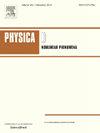Stabilized quasi-monotone semi-Lagrangian high-order finite element method for a nonhydrostatic ocean model
IF 2.7
3区 数学
Q1 MATHEMATICS, APPLIED
引用次数: 0
Abstract
We present a high-order finite element method combined with a stabilized quasi-monotone semi-Lagrangian scheme to compute numerical solutions for a nonhydrostatic ocean model. This model is governed by the full incompressible Navier–Stokes equations, coupled with convection–diffusion equations for salinity and temperature, and an equation of state for seawater. Ocean models based on semi-Lagrangian schemes can lead to spurious oscillations near sharp gradients in the solution, often resulting in numerical instabilities and unphysical values such as negative salinity. A novel feature of the proposed method is the use of mesh adaptation strategies to identify elements affected by spurious oscillations, applying the so-called quasi-monotone scheme. The approach is tested on classical two-dimensional convection–diffusion problems, which share governing equations with those used for salinity and temperature conservation, and is validated against published results for stratified oceanic flows. The numerical results demonstrate the effectiveness of the proposed method in achieving high-order accuracy in smooth regions while reducing spurious oscillations near sharp gradients, resulting in stable and accurate numerical solutions for convection–diffusion problems and stratified ocean flows.
非流体静力海洋模型的稳定拟单调半拉格朗日高阶有限元法
本文提出了一种结合稳定拟单调半拉格朗日格式的高阶有限元方法来计算非流体静力海洋模型的数值解。该模型由完全不可压缩的Navier-Stokes方程、盐度和温度的对流扩散方程以及海水的状态方程控制。基于半拉格朗日格式的海洋模式可能在溶液的陡峭梯度附近导致虚假振荡,经常导致数值不稳定和非物理值,如负盐度。该方法的一个新特点是使用网格自适应策略来识别受杂散振荡影响的元素,应用所谓的准单调方案。该方法在经典的二维对流扩散问题上进行了测试,该问题与用于盐度和温度守恒的问题共享控制方程,并与已发表的分层海洋流动结果进行了验证。数值结果表明,该方法能够在光滑区域获得高阶精度,同时减少陡坡附近的杂散振荡,从而得到对流扩散问题和分层海洋流动的稳定、精确的数值解。
本文章由计算机程序翻译,如有差异,请以英文原文为准。
求助全文
约1分钟内获得全文
求助全文
来源期刊

Physica D: Nonlinear Phenomena
物理-物理:数学物理
CiteScore
7.30
自引率
7.50%
发文量
213
审稿时长
65 days
期刊介绍:
Physica D (Nonlinear Phenomena) publishes research and review articles reporting on experimental and theoretical works, techniques and ideas that advance the understanding of nonlinear phenomena. Topics encompass wave motion in physical, chemical and biological systems; physical or biological phenomena governed by nonlinear field equations, including hydrodynamics and turbulence; pattern formation and cooperative phenomena; instability, bifurcations, chaos, and space-time disorder; integrable/Hamiltonian systems; asymptotic analysis and, more generally, mathematical methods for nonlinear systems.
 求助内容:
求助内容: 应助结果提醒方式:
应助结果提醒方式:


